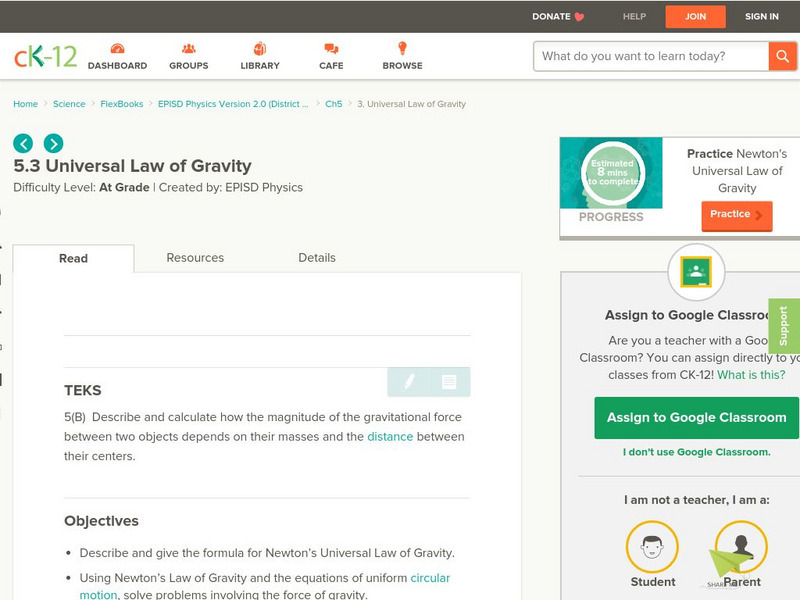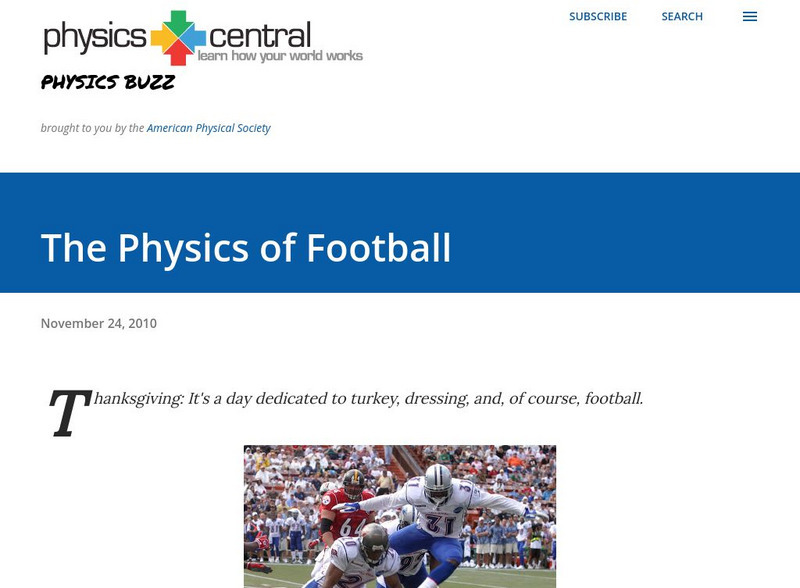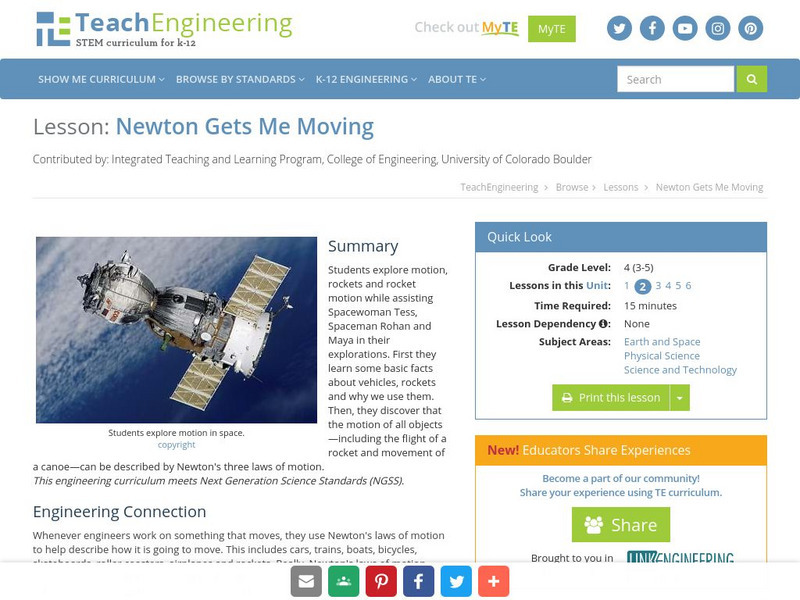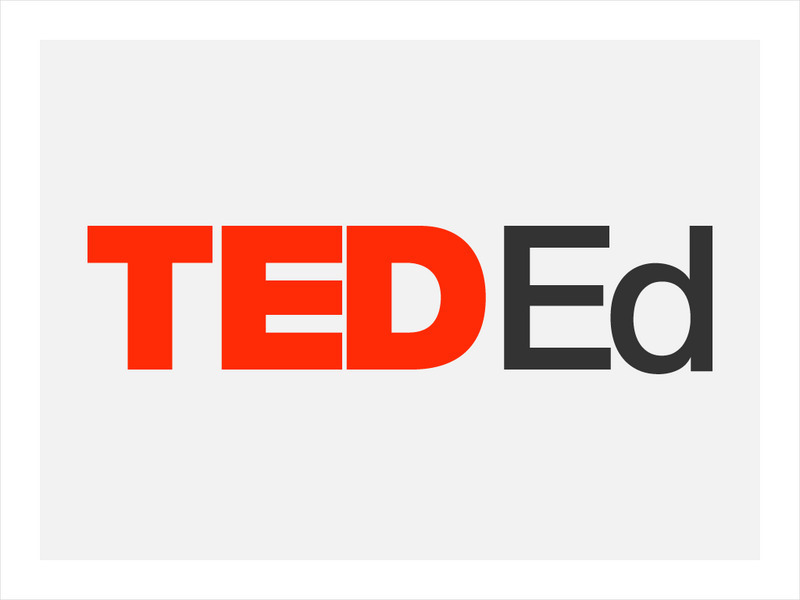Hi, what do you want to do?
TeachEngineering
Teach Engineering: Action Reaction! Rocket
Students construct a rocket from a balloon propelled along a guide string. They use this model to learn about Newton's three laws of motion, examining the effect of different forces on the motion of the rocket.
Georgia State University
Georgia State University: Hyper Physics: Kepler's Laws
An outstanding page describing Kepler's three laws of planetary motion.
CK-12 Foundation
Ck 12: Universal Law of Gravity
[Free Registration/Login may be required to access all resource tools.] In this online tutorial students will learn to describe and calculate how the magnitude of the gravitational force between two objects depends on their masses and...
Physics Central
Physics Central: Physics Buzz Blog : The Physics of Football
Football is a sport almost made for physicists. Newton's three laws of motion are at work during every play and little things like the unpredictable bounce of the "prolate spheroid" - the football - can throw kinks into a game no...
Cosmo Learning
Cosmo Learning: Newton's Laws
Do you need to review any of Newton's three laws? This website contains a video collection on Newton's Law from a physics course at East Los Angeles College. In twelve lectures, each law is explained with examples. Also discussed is...
TeachEngineering
Teach Engineering: Newton Gets Me Moving
In this activity, young scholars will explore motion, rockets and rocket motion while assisting Spacewoman Tess, Spaceman Rohan and Maya in their explorations. They will first learn some basic facts about vehicles, rockets and why we use...
Science4Fun
Science4 Fun: Isaac Newton
Brief biographical sketch of Isaac Newton, famous scientist whose discoveries include the law of gravitation, three laws of motion, reflective telescope, and calculus.
TeachEngineering
Teach Engineering: Mechanics Mania
Through ten lessons and numerous activities, students explore the natural universal rules engineers and physicists use to understand how things move and stay still. Together, these rules are called "mechanics." The study of mechanics is...
NASA
Nasa: Kepler and His Laws
This site from NASA provides biographical details about the lives of Tycho Brahe and Johannes Kepler. Discusses Kepler's successes at developing laws of planeatry motion. States the three laws and discusses each one individually....
Cornell University
Cornell University: Astronomy: Orbital Motion and Kepler's Laws
At this site from the Astronomy Department of Cornell University, Kepler's three laws of planetary motion are stated. There are brief explanations of each, along with links to additional information on related subjects.
American Association of Physics Teachers
Com Padre Digital Library: Open Source Physics: Remarkable Three Body Motions
What happens in space when a third celestial body joins two others? Discover both simple and complex situations which occur supporting Newtonian law in space with this collection of applets.
CK-12 Foundation
Ck 12: Plix Series: Newton's First and Second Laws
[Free Registration/Login Required] Read a force scenario, and then analyze the graphs provided to gain an understanding of inertia and force. After the activity, answer three challenge questions to check for understanding.
Georgia Department of Education
Ga Virtual Learning: A Brief History of Astronomy
In this interactive module students will explore what different ancient cultures believe was an explanation of the stars and planets. They will look at how the work of Nicolas Copernicus revolutionize the world of astronomy and learn how...
TeachEngineering
Teach Engineering: Rockets
This unit teaches students how and why engineers design satellites to benefit life on Earth as well as allows students an opportunity to explore motion, rockets and rocket motion. Students discover that the motion of all objects...
TeachEngineering
Teach Engineering: Up, Up and Away! Airplanes
The airplanes unit begins with a lesson on how airplanes create lift, which involves a discussion of air pressure and how wings use Bernoulli's Principle to change air pressure. Following the lessons on lift, students explore the other...
Physics Classroom
The Physics Classroom: Vectors: Forces in Two Dimensions: Addition of Forces
In this tutorial, examine the effect of forces acting at angles to the horizontal, such that the force has an influence in two dimensions- horizontally and vertically.
Cosmo Learning
Cosmo Learning: Physics 240: Science and Engineering I
A collection of video lectures from a physics for science and engineering course taught at the University of Missouri-Kansas City. The course discusses the concepts of mechanics, wave motion, sound, heat and thermodynamics in thirty-five...
Other
Wikibooks: Physics Study Guide
A handy resource that gives an overview of equations and definitions pertinent to an introductory, college-level physics course, with two of its three sections focusing on motion-related topics and principles.
Annenberg Foundation
Annenberg Learner: Colliding Cars
Try to predict what will happen in three different bumper car collisions. For each collision, you'll be shown two possible outcomes.
Soft Schools
Soft Schools: Physics Quizzes: Force, Mass Acceleration
Assess your understanding of force, mass and acceleration and the relationship amongst the three with this interactive multiple choice quiz. Immediate feedback is offered.
Cosmo Learning
Cosmo Learning: Fundamentals of Physics
A collection of video lectures from a fundamentals of physics course taught at Yale University. The course is an introduction to physics and discusses Newtonian mechanics, special relativity, gravity, thermodynamics, and waves. Course...
Concord Consortium
Concord Consortium: Newton's Laws at the Atomic Scale
Explore how Newton's three laws apply to the world of atoms and molecules. Start with the originally contradictory observation of Brownian motion. Then, each law is addressed at the atomic level.
Physics Classroom
The Physics Classroom: Vectors: Forces in Two Dimensions:equilibrium and Statics
Through examples and practice problems, this interactive tutorial helps students understand forces that are in a state of equilibrium with a net force of zero.
TED Talks
Ted: Ted Ed: If Superpowers Were Real: Flight
Is it scientifically possible to fly? In this series, creator Joy Lin tackles six superpowers and reveals just how scientifically realistic they can be to us mere mortals. [5:11]





















